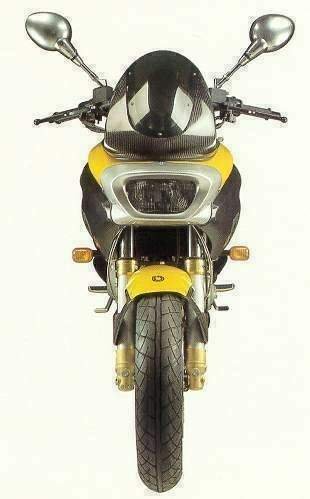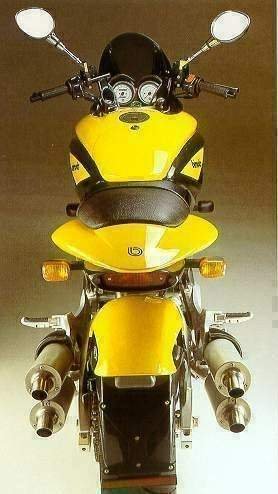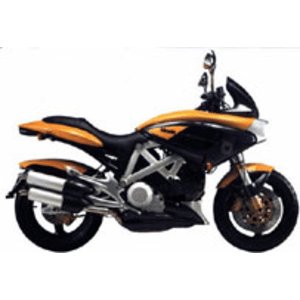Bimota DB3 Mantra [1995-1998]: A Radical Italian Sculpture That Rides Like a Dream

Introduction
The Bimota DB3 Mantra isn’t just a motorcycle—it’s a statement. Born from the rebellious minds at Bimota in the mid-’90s, this machine defied conventions with its avant-garde design and engineering audacity. Built around Ducati’s iconic 904cc V-twin engine, the Mantra was a daring departure from Bimota’s traditional race-replica focus, targeting riders who craved exclusivity and head-turning style without sacrificing performance. Over three years and just 454 units produced, the Mantra carved its niche as a "naked bike" that felt anything but ordinary. Let’s dive into what makes this Italian oddity so unforgettable.
Design: A Rolling Art Installation

French designer Sacha Lakic’s vision for the Mantra was equal parts futuristic and controversial. From its Ferrari-inspired grille-like headlight surround to the quartet of low-slung mufflers, every angle screams intentional provocation. The bodywork—a mix of angular plastics and carbon fiber accents—wraps around an oval-section aluminum frame that looks more like aerospace hardware than motorcycle engineering.
Slip into the rider’s seat (780 mm / 30.7 inches), and the details keep coming: a walnut-dash instrument panel with white-faced gauges, chrome "pear-shaped" mirrors, and a dummy fuel tank hiding a tiny storage compartment. The actual fuel sits in twin saddlebags flanking the frame, lowering the center of gravity. It’s a design that prioritizes drama over practicality—the mirrors vibrate slightly at idle, and the turn signals feel like afterthoughts—but that’s precisely the point. This is a bike for riders who want to be seen, not ignored.
Performance: Ducati’s Heart, Bimota’s Soul
The Mantra’s 904cc air-cooled V-twin—lifted from Ducati’s 900SS—delivers 86 HP (63 kW) at 7,000 RPM and a meaty 92 Nm (67.9 lb-ft) of torque at 5,700 RPM. Those numbers don’t scream "superbike," but the Mantra’s featherweight 185 kg (407.9 lbs wet) transforms the experience.
Throttle Response: Crack open the twin 38mm Mikuni carburetors, and the Mantra lunges forward with the urgency of a lightweight boxer. The torque curve is addictive—90% of peak torque arrives by 3,500 RPM, making city riding a game of effortless overtakes. First-gear wheelies require minimal provocation, and the six-speed gearbox (though not buttery-smooth) slots cleanly under load.
Top Speed & Refinement: Bimota claims a top speed of 207 km/h (128.6 mph), but the Mantra feels happiest between 100-160 km/h (62-99 mph). The air-cooled engine thrums with mechanical character, though vibrations creep into the bars at higher revs. The four-exhaust setup looks phenomenal but prioritizes aesthetics over acoustics—it’s more subdued than a typical Ducati rumble.
Handling: Agile, But With a Caveat

Bimota’s chassis wizardry shines here. The oval-tube frame and braced aluminum swingarm offer laser-sharp feedback, while the 43mm Paioli forks (rebound-adjustable) and single Paioli rear shock (compression/rebound/length-adjustable) strike a balance between compliance and control.
Steering Geometry: With a 24° rake and 92mm (3.6 inches) of trail, the Mantra turns quicker than its radical looks suggest. The wide handlebars (a first for Bimota) leverage a 1370mm (53.9-inch) wheelbase for stability mid-corner. However, the steering lock is comically limited—U-turns demand three-point turns.
Braking: Twin 320mm front discs with Brembo P4 calipers deliver race-grade stopping power. The initial bite is fierce, requiring a delicate touch in wet conditions. Michelin Macadam tires (120/70 front, 180/55 rear) offer decent grip for the era, though modern rubber would unlock hidden potential.
Competition: How Does It Stack Up?
The Mantra’s closest rival was the Ducati Monster M900—essentially its donor bike stripped to basics. Here’s how they compare:
| Feature | Bimota DB3 Mantra | Ducati Monster M900 | |-----------------------|----------------------------------|----------------------------------| | Engine | 904cc V-twin (86 HP) | 904cc V-twin (73 HP) | | Weight | 185 kg (407.9 lbs) | 198 kg (436.5 lbs) | | Frame | Oval-section aluminum | Steel trellis | | Suspension | Fully adjustable Paioli | Non-adjustable Marzocchi | | Exclusivity | 454 units produced | Mass-produced | | Personality | Avant-garde showstopper | Minimalist streetfighter |
The Mantra out-handles the Monster thanks to its premium suspension and lighter weight, but Ducati’s offering was far more affordable and practical. Other competitors like the Triumph Speed Triple (885cc, 98 HP) offered more power, while the Honda CB1000 (998cc, 100 HP) prioritized reliability. The Mantra’s appeal lay in its exclusivity—a rolling sculpture for riders bored with convention.
Maintenance: Keeping the Mantra Alive

Owning a Mantra means embracing its quirks. Here’s what to watch:
- Engine Care:
- The Desmo valvetrain demands strict 12,000 km (7,456 mi) service intervals for valve adjustments.
-
Carburetors (Mikuni BST38) benefit from annual cleaning if ridden infrequently.
-
Electronics:
-
The analog ignition system is reliable but primitive. Consider upgrading to a modern electronic ignition kit for smoother cold starts.
-
Suspension:
-
Paioli fork seals degrade over time. MOTOPARTS.store offers rebuild kits with upgraded polymers.
-
Brakes:
-
Swap factory brake pads for sintered variants to reduce fade during aggressive riding.
-
Exclusive Parts:
- The four-exhaust system is prone to corrosion. Stainless-steel replica headers are available.
Pro Tip: The Mantra’s air-cooled engine runs hot in traffic. Install an oil cooler kit (not OEM) for added protection in summer climates.
Conclusion: A Cult Classic That Deserves Revival
The Bimota DB3 Mantra isn’t for everyone—its polarizing looks and niche parts supply demand commitment. But for those willing to embrace its madness, it’s a revelation. The combination of Ducati’s grunty V-twin, Bimota’s chassis mastery, and Lakic’s boundary-pushing design creates a motorcycle that feels alive beneath you. It’s a time capsule of ’90s Italian audacity, proof that motorcycles can be both art and adrenaline.
Whether you’re restoring one or simply daydreaming, MOTOPARTS.store has the expertise and components to keep your Mantra breathing fire. From period-correct NGK spark plugs (DPR8EA-9 / DPR8EIX-9) to bespoke exhaust upgrades, we’re here to ensure this Italian icon never fades into obscurity.
Ride bold. Ride different. Ride Bimota.
Specifications sheet
| Engine | |
|---|---|
| Stroke: | Four-stroke |
| Ignition: | Analog with inductive discharge |
| Max power: | 63 kW | 84.0 hp |
| Max torque: | 90 Nm |
| Fuel system: | 38mm Mikuni carburetor |
| Max power @: | 7000 rpm |
| Displacement: | 904 ccm |
| Max torque @: | 5500 rpm |
| Configuration: | V |
| Cooling system: | Air-cooled |
| Compression ratio: | 9.2:1 |
| Number of cylinders: | 2 |
| Valves per cylinder: | 2 |
| Dimensions | |
|---|---|
| Dry weight: | 172 |
| Wet weight: | 185 |
| Seat height: | 780 mm (30.7 in) |
| Fuel tank capacity: | 14 L (3.7 US gal) |
| Drivetrain | |
|---|---|
| Final drive: | chain |
| Transmission: | 6-speed |
| Maintenance | |
|---|---|
| Engine oil: | 10W40 |
| Brake fluid: | DOT 4 |
| Spark plugs: | NGK DPR8EA-9 or NGK DPR8EIX-9 |
| Spark plug gap: | 0.9 |
| Engine oil change interval: | Every 5000km or 2 years, whichever comes first |
| Valve clearance check interval: | Not applicable (desmodromic valve system) |
| Additional Notes | |
|---|---|
| Top speed: | 207 km/h (128.6 mph) |
| Production units: | 454 |
| Special features: | Adjustable suspension, dual fuel storage compartments, optional windscreen |
| Standing ¼ Mile: | 11.9 sec @ 175.0 km/h (108.7 mph) |
| Chassis and Suspension | |
|---|---|
| Rake: | 24° |
| Frame: | Perimeter structure made of oval-section tubes |
| Trail: | 92 mm (3.6 in) |
| Rear tire: | 180/55 z-17 |
| Wheelbase: | 1370 mm (53.9 in) |
| Front tire: | 120/70 z-17 |
| Rear brakes: | Single 230 mm disc, 2-piston Brembo caliper |
| Front brakes: | 2 x 320 mm floating discs, 4-piston Brembo calipers |
| Rear suspension: | Single Paioli shock absorber, compression, rebound, and preload adjustable |
| Front suspension: | 43mm Paioli telescopic fork, rebound adjustable |


















